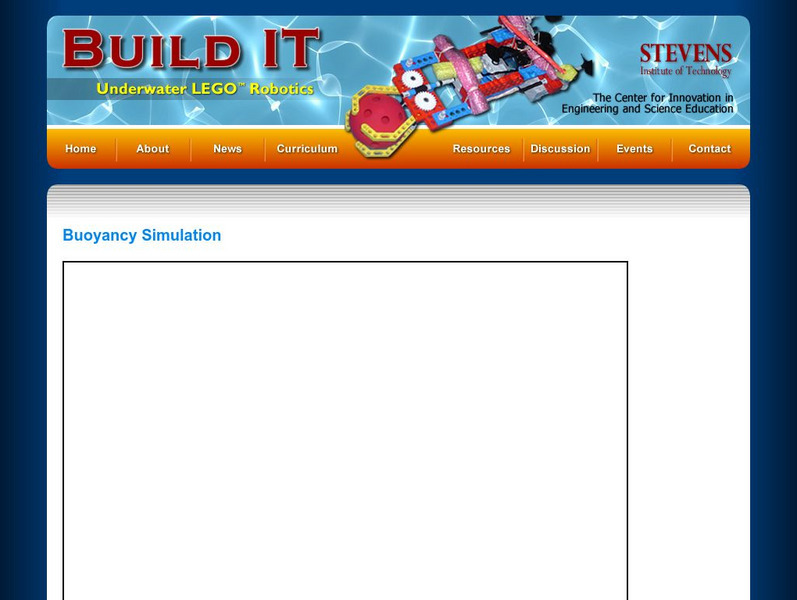Hi, what do you want to do?
Curated OER
Floating Fishes: How do Fishes Control Buoyancy?
Playing with balloons, water, oil, and bottles help put this instructional activity over the top! Participants use air-filled balloons in water tanks to experience gas compression. They also use oil-filled bottles to experiment with...
Teach Engineering
Above-Ground Storage Tank Design Project
The challenge: determine whether a tank will float. A design activity has groups work as engineering teams in order to determine the stability of given tanks and liquid contents. The teams need to determine the equations to...
Curated OER
Which Objects Will Sink or Float?
First graders work in cooperative groups and utilize a variety of materials to test objects ability to sink or float. In this sink or float lesson, 1st graders discover why some object sink and others float. Students will graph results...
Curated OER
Floating and Sinking
Students conduct experiments in which they investigate which materials float and which sink. They examine what qualities the materials that float have in common. They carry out a scientific investigation, predict, and test their...
Curated OER
Made to Sail
Students use simple materials to make model sailboats which must stay upright and sail straight in a testing tank.
Curated OER
What Floats Your Boat?
Students explore the principles of buoyancy and Archimedes' Principle and design their own flotation device. They compare the dimensions of a model to the real object to determine scale and analyze the models to suggest improvements.
Curated OER
Vegetable Olympic Swimming: Will it Float?
Students inspect nutrition by conducting a science experiment in class. In this vegetable identification lesson, students examine a group of different veggies and predict whether they will sink or float in a tub of water. Students check...
Curated OER
Floating Soap
Students explore the density of soap. In this science instructional activity, students conduct an experiment to find which types of soap will float. Students make a hypothesis and record their observations.
Curated OER
Regular Coke vs. Diet Coke: Which is Denser?
Learners define the terms "mass," "volume," and "density." The relationship between these three terms is established. They observe the differences between Regular and Diet Coke. They develop an hypotheses about why a can of Regular Coke...
California Academy of Science
Buoyancy Bulls-Eye
Why does a seastar sink, but a jellyfish float? Through a fun investigation, learners examine the concept of buoyancy using simple household items. The challenge: create neutral buoyancy for an action figure in water. With ample...
Curated OER
Cruising
Cruise ships offer many engaging opportunities for real-world math adventures. These large, floating cities use resources with numbers into the thousands place. Young mathematicians are asked to calculate numerical information...
Curated OER
Density Demonstration: Coke vs. Diet Coke
In this density demonstration, students compare a can of diet coke to a can of regular coke. They list the similarities and differences of each prior to the demonstration. The cans are placed in a tank of water and students record their...
Curated OER
Mystery Canisters
In this density learning exercise, students modify three film canisters in order to make one float in a tank of water, another suspend in the middle of the tank, and the third should sink to the bottom. They collect data on their...
American Chemical Society
Defining Density
Three simple activities kick off a unit investigation of density. Your physical scientists make observations on the volume and mass of wood, water, and rocks, and make comparisons. Though this is written for grades three through eight,...
US Environmental Protection Agency
Thirstin's Wacky Water Adventure
Make a splash with young scientists as you teach them all about water using this activity packet. Thirstin, a cartoon glass of water, walks children through the water treatment process, teaches them about different sources of water, and...
Curated OER
Your Own Fresh Water Aquarium in the Classroom
Students explore aquariums. In this fish and ecosystems lessons, students establish a freshwater aquarium environment using materials provided. Students read about and care for the classroom fish.
Curated OER
Fisheries
Students research and report on the ocean's problems of disappearing or diminishing species around the world. students examine ecosystems and food chains and present their findings to a mock panel of science experts.
Curated OER
Regular Coke versus Diet Coke, Which is Denser?
Students investigate the density of liquids. In this geometry lesson, students calculate the volume and differentiate between volume, mass and density. They observe similarity and differences between coke and diet coke.
Curated OER
Groundwater Pollution Site Assessment
Students study how a geologist examines a hazardous waste spill using an actual site. They use site data to map the spill, find its source and determine how fast the spill is spreading.
Curated OER
Lawnchair Larry Flies!
Students research and experiment to discover the lifting power of helium gas.
Curated OER
"Pennsylvania Watersheds, Many Ways to the Sea"
Students trace a molecule of water through the water cycle including each of its three loops. They describe why evapotranspiration demands the largest portion of total precipitation falling on a forested watershed.
Curated OER
Balloon Bustin' Biographies
Students choose a famous person to write a one to three page report about. They conduct research using electronic encyclopedias, biographies, and videos. When students have all presented their reports, the class has a party.
Center for Innovation in Engineering and Science Education, Stevens Institute of Technology
Stevens Institute of Technology: Buoyancy Simulation
By choosing the mass, size, and time, students can experiment with whether the block floats or sinks in this simulation. Students have the option to display the forces and add a second block to the tank. Density is also shown to allow...



























